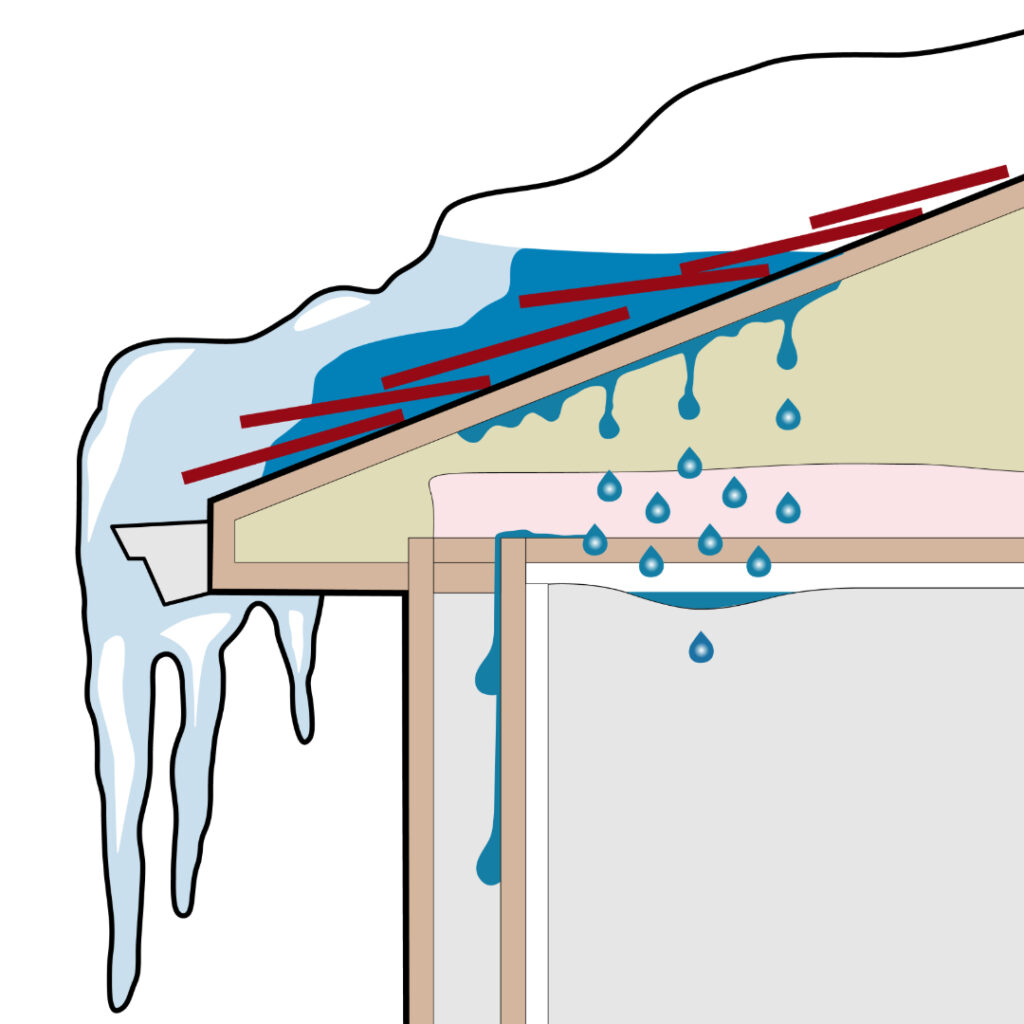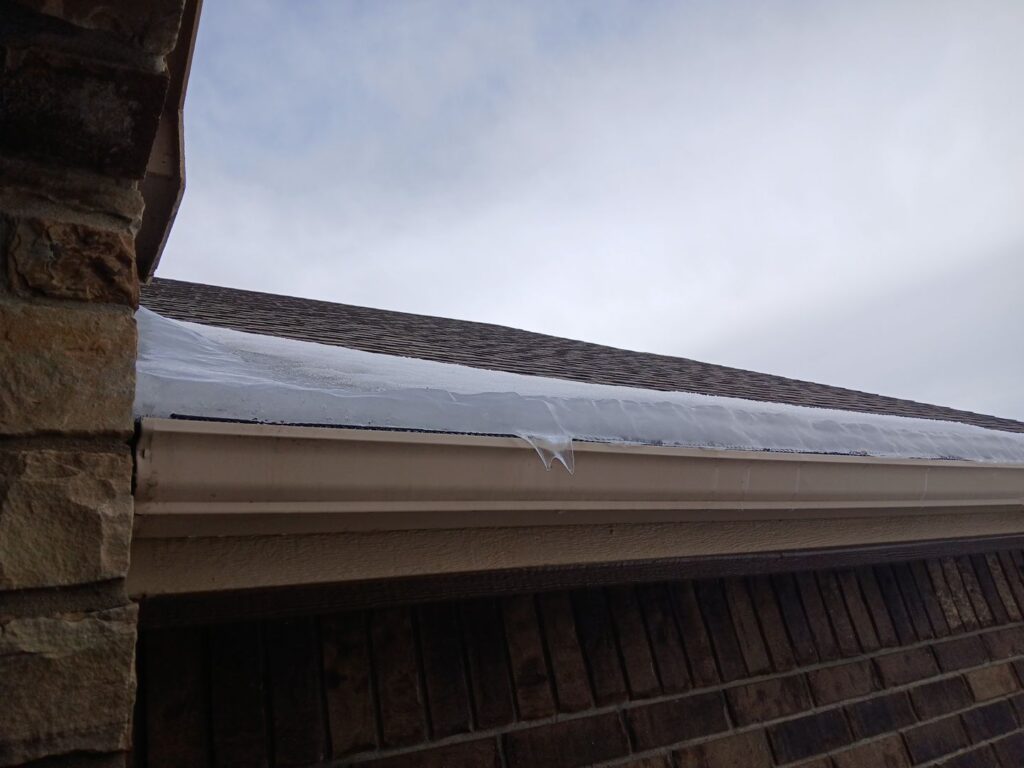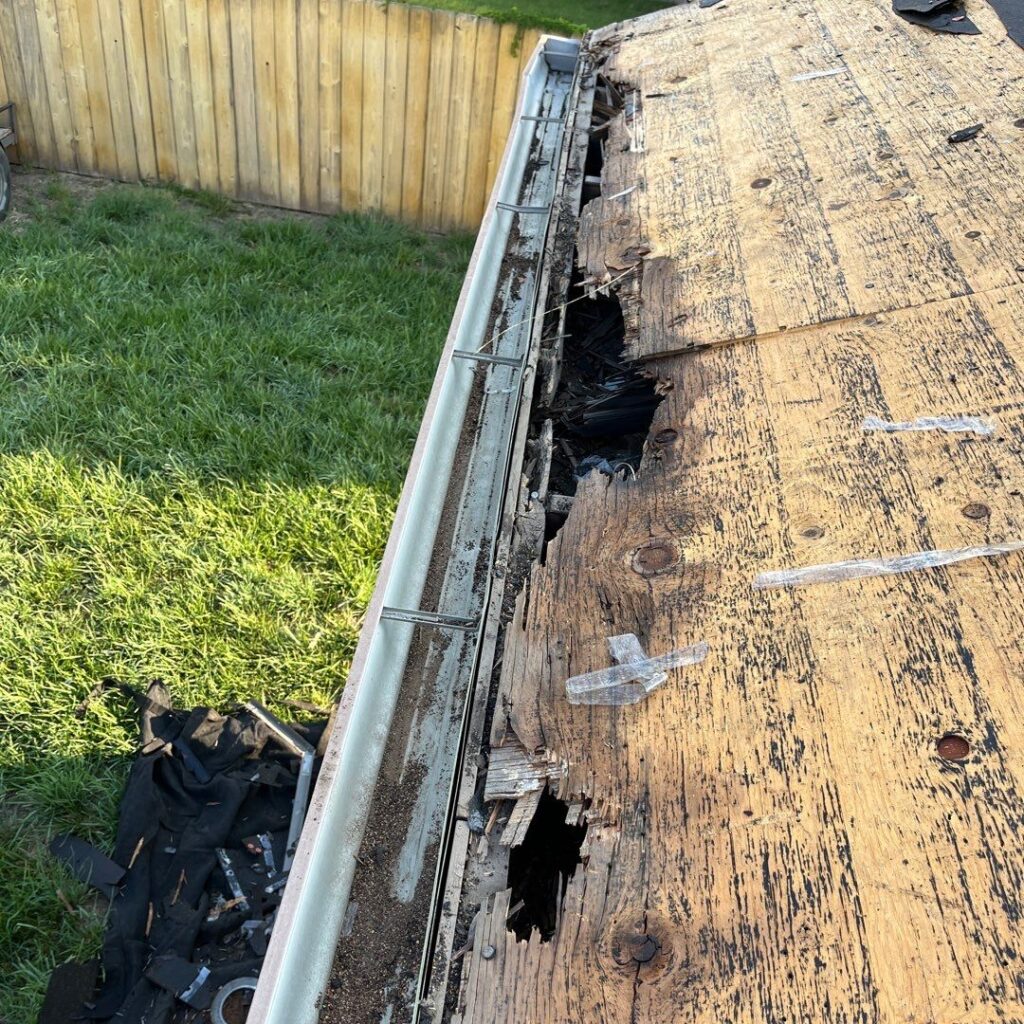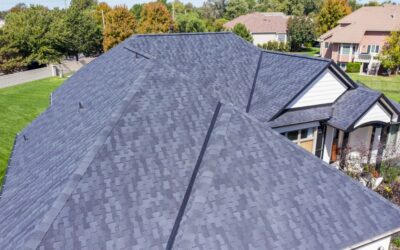What Are Ice Dams?
When it’s cold enough to freeze your eyebrows, water isn’t supposed to be a problem.
But on sloped roofs in the winter, snow doesn’t always melt the way it should. If it melts near the top of the roof but refreezes at the eaves, it can form a dam that backs water under your shingles, and often into your ceiling.
This article walks through how ice dams form, how they cause damage, and how to address them.
And if it helps, think of it this way: an ice dam isn’t a roofing failure – it’s a physics failure. Your roof just happened to be involved.

What Causes Ice Dams on Roofs?
Ice dams form when snow on a roof melts near the ridge or field but remains frozen at the eaves. Sloped roofs are designed to shed water. But, when water doesn’t drain properly, it can back up under the shingles, infiltrate beneath the underlayment, and eventually leak into the home’s interior.
For an ice dam to form, two things must happen:
- Snow melts higher up on the roof – in the field upslope or near the ridge.
- That melted water reaches the eaves, where snow hasn’t melted and the water can freeze.
If you can prevent either of these conditions, you can stop ice dams from causing interior leaks.
This gives roofers two options:
- Prevent upslope snow from melting before it melts at the eaves.
- Or melt the eaves’ snow and ice faster to match the rate it melts up-slope.
Of the two options, the first is usually more practical and effective.
When snow melts upslope, it freezes at the colder eaves, forming ice. Maintaining a consistent roof temperature that approximates ambient temperature – the temperature of the surrounding outdoor air – prevents this from occurring.
Why Eaves Are Prone to Ice Dams
We wrote an article about proper attic ventilation that goes into more detail on this topic. Here’s the gist of it.
Because they overhang from the roof, your eaves don’t know your house exists.
Unlike the rest of your roof, which sits above a space full of central heating, heat-producing people, appliances and lightbulbs, the eaves hang over thin air. No heat rises into them. They’re exposed on all sides to the outside world, and in winter, the outside world is cold.
When snow melts higher up the roof, either because the attic is warmer than the ambient temperature or the sun is heating it, the meltwater’s descent will stop at the freezing eaves. The more snow that melts up-slope, the bigger the dam becomes.
All because part of your roof is heated by a warm house, and part of it is hanging off the edge of it.
A shorter overhang is less exposed to the cold outside air and is closer to the house’s warmth, making it less likely to freeze and form an ice dam.

How Climate and Weather Influence Ice Dam Formation
If winter is 50 degrees Fahrenheit and sunny where you live, you won’t experience ice dams: there’s no snow to melt and refreeze.
In the lower Midwest, where winter temperatures regularly drop below freezing, ice dams are a regular cause of leaks. While the likelihood of ice dams forming in each climate is primarily determined by the ambient temperature, they can be exacerbated by a few factors.
- Tree Coverage. Sunlight contributes to snow melt across the roof, including the eaves. But when trees obstruct the sun, shaded eaves are more likely to remain frozen. This increases the chance that melted water from higher up will refreeze at the eave.
- Freeze-Thaw Cycles. During the day, as temperatures exceed 32 degrees Fahrenheit, snow begins to melt. When the temperature dips back below freezing at night, any melted water trapped at the eaves refreezes and contributes to a bigger ice dam. If this cycle continues – temperatures marginally exceeding freezing during the day and dipping below freezing at night – ice dams can grow considerably.

Rotted Decking at Eaves from Ice Damming

Freezing Eaves Ice Dam
Where Ice Dams Cause Roof and Home Damage
Ice dams cause water infiltration. What makes water infiltration at the eaves particularly troublesome is the many paths that water can take. The water plays Plinko, and it can cause damage at every stop.
- If it slips under the shingles, it can soak the roof deck. This causes fastening issues for shingles and underlayment, as well as visible sagging over time. As the foundation of your roof, damage to the roof deck can cause costly damage if left untreated.
- If it finds a nail hole in the roof deck or soaks it through, it can reach your attic, soaking the insulation or structural members. Some insulation retains water, but all insulation struggles to insulate properly when it’s wet.
- If it runs along the eaves, it can track behind fascia boards or into the soffits. Water damage to fascia is often hidden behind gutters, and sagging gutters after heavy snowfall can be a sign of rotted fascia. Soffit damage is harder to spot. Icicles hanging under the eaves or especially soffits can be a sign that water has already infiltrated. If you notice this, call an experienced roofing contractor immediately.
- If it runs along framing, it can show up on your ceiling as a stain, drip, or a bubble in the paint. Along this path, water can leak behind your walls as well. Inside, this manifests as either bubbles under the paint or discolored stains on the wall or ceiling. The same symptoms can manifest outside in the siding.
How to Prevent Ice Dams on Your Roof
Improve Attic Ventilation to Prevent Ice Dams
The best way to prevent ice dams is to prevent snow from melting unevenly. Proper attic ventilation does this by maintaining near-ambient temperature in the attic space.
Soffit vents pull in cold air at the bottom, and the ridge, box, or turbine vents let warm air escape at the top. Together, they maintain steady airflow with passive ventilation that keeps the roof deck at or near the ambient temperature.
Most homes that we re-roof previously had inadequate attic ventilation. But the math behind proper ventilation is surprisingly simple: for every 150 square feet of attic floor space (or 300, depending on the roof), you need at least 1 square foot of net free area (NFA) – the open, unobstructed space where air can flow. Some exceptions exist, but generally half of the NFA should be intake (e.g., soffit vents), and half should be exhaust (e.g., ridge or box vents).
If insulation blocks the soffit vents, airflow will begin to stall. Warm air rises and pools beneath the roof deck, heating it and causing snow to melt prematurely. Then the freeze-refreeze cycle that forms ice dams begins.
Using a Roof Rake to Remove Snow and Reduce Ice Dams
Another way to prevent ice dams is to clear the snow before it can melt and refreeze. The National Weather Service recommends roof rakes, extendable tools that let you rake snow off your roof while standing on the ground.
It prevents ice dams by removing one of its two main ingredients: snow. But it’s not sustainable. Roof raking only clears snow you can reach from the ground, which often leaves snow near the ridges unaffected. Plus, your roof might thank you, but your shoulders won’t.
Install Ice and Water Shield as a Redundancy
As a final measure, qualified roofing contractors install a self-adhering waterproof membrane called Ice and Water Shield. It’s adhered directly to the roof deck and typically extends at least 24” beyond the interior wall line, forming a barrier beneath the shingles.
If standing water behind an ice dam gets past the shingles and underlayment, Ice and Water Shield stops it cold.
It’s not a substitute for ventilation, but it’s a valuable redundancy that’s installed in the hope that this entire article will never apply to you.
Can Gutters Cause Ice Dams?
Clogged gutters don’t cause ice dams. Uneven roof temperatures do. However, clogged gutters trap standing water, and standing water freezes faster than flowing water. That ice can back up beneath shingles, contribute to the ice dam, and even pull gutters away from the house.
A good rule of thumb: if your gutters hold water after a spring shower, they’re likely to exacerbate ice dams in the winter.
Preventing Ice Dams Starts with an Inspection
If you’ve delt with ice dams before, you know the damage isn’t always noticeable until it’s expensive.
Not sure if your attic ventilation meets current building standards? We inspect for ice-dam-prone conditions and provide solutions that keep physics on your side.



